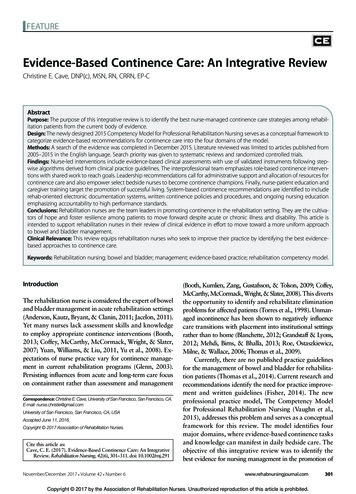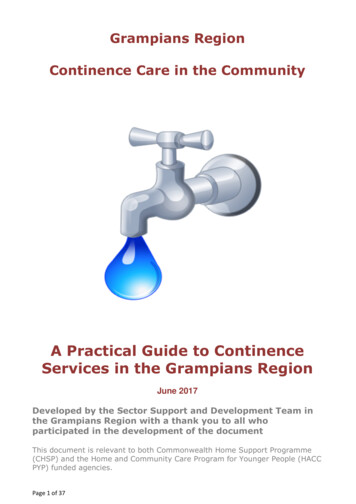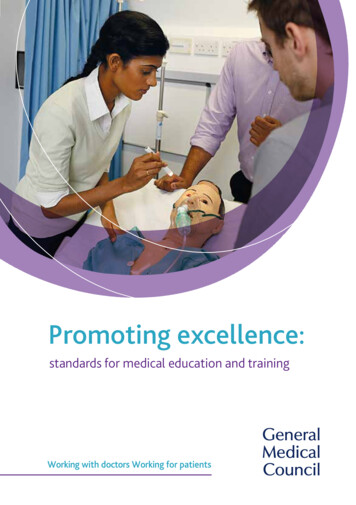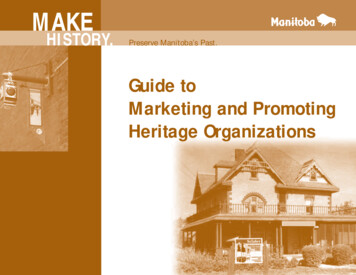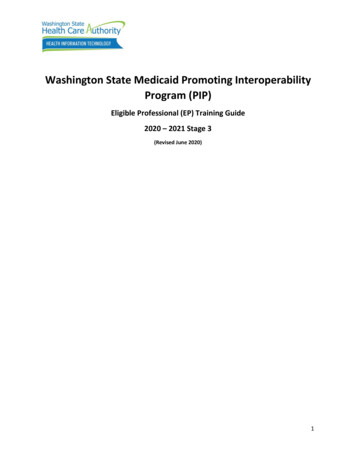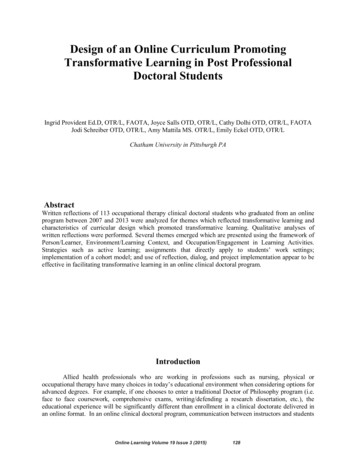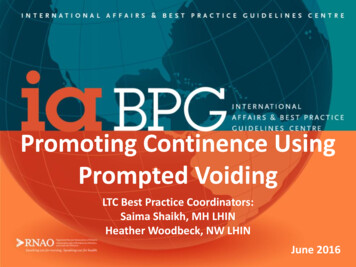
Transcription
Promoting Continence UsingPrompted VoidingLTC Best Practice Coordinators:Saima Shaikh, MH LHINHeather Woodbeck, NW LHINJune 2016
AcknowledgementsThis presentation was adapted from the IC3: ImprovingContinence Care Collaborative, 2008-12.2
Objectives Discuss factors that impact continence Review recommendations from PromotingContinence Best Practice Guideline Share ideas for developing Individualizedtoileting/prompted voiding schedules Share tips for implementing prompted voiding Discuss ways to overcome barriers and challenges
Long-Term Care Best Practices Toolkit, 2nd edition4
Promoting Continence UsingPrompted Voiding BPG Provides information onimplementing a prompted voidingprogram Practice Recommendations: Assessment Planning Implementation Evaluation5
Assessment Recommendations1.0 Obtain a history of the resident's incontinence.2.0 Gather information on:– The amount, type and time of daily fluid intakeincluding caffeine and alcohol.– The frequency, nature and consistency of bowelmovements.– Any relevant medical or surgical history which may berelated to the incontinence problem eg. diabetes,stroke, Parkinson's disease, heart failure, recurrenturinary tract infections or previous bladder surgery.6
Types of Urinary Incontinence Physical : Stress: cough, laugh, etc. Urge: need to go Now Overflow: leaks out Functional: Person needs help Transient Short term problem
Overview of Continence Factors Current Medical ProblemsCognitive ImpairmentPast Medical/Surgical HistoryOverweightAging: Loss of pelvic muscletone & atrophic changes Urinary Tract Infections Low Fluid IntakeCaffeine / Alcohol IntakeConstipationDecreased MobilityEnvironmental FactorsMedications
Assessment Recommendations 3.0 - Review the client's medications thatmay have an impact on incontinence. 4.0 - Identify the client's functional andcognitive ability. 5.0 - Identify attitudinal andenvironmental barriers to successfultoileting.9
Medications That Impact Continence Anti-hypertensives - Postural hypotension leads tofunctional urinary incontinence (UI). Diuretics - Diuresis causes overflow incontinence Calcium Channel Blockers - Constipation, diarrhea Antacids with aluminum - laxative effect, can cause diarrheaor loose stools Laxatives - Diarrhea, intestinal cramping, fecal incontinence. Antidepressants - Constipation, especially in elderly.Contribute to overflow and functional UI.Problems with urination and loss of bladder control. Monoamine oxidase inhibitors (MAO’s) - Urinary retention. Anti-psychotics - Constipation, confusion, sedation, rigidityand immobility leading to overflow and functional UI.Adapted from: AHCPR. 2006. Urinary fcgi?rid hstat6.section.10079.; Brigham & Women’s Hospital10
More Meds That Impact Continence Sedative/Hypnotic/ Barbiturate - Can cause excessive sedationand decreased mobility in elderly people predisposing them tofunctional UI. Not commonly used in long term care. Narcotics - Constipation and confusion leading to overflow andfunctional urinary incontinence. NSAIDS – Urinary retention in elderly and/or arthritic patients (inlarge doses) Anticholinergic/ Antispasmodic/ Antiemetics - Constipation andurinary retention leading to overflow and functional UI Cholinergic -Cause urge incontinence due to bladder relaxation.Not commonly used in long term care. Anti-Parkinson agents - Constipation, diarrheaAdapted from: AHCPR. 2006. Urinary fcgi?rid hstat6.section.10079.; Brigham & Women’s Hospital11
Resident CapabilitiesFunctional Barriers Affect resident's abilityto get a toilet on time:– Access to bathroom– Ambulation assistance– Wheelchair– Transfer aids– Adaptive clothing/environmentCognitive Capacity awareness of urge to void able to get to the bathroom able to suppress the urgeuntil resident reaches thebathroom able to void when residentgets to the BR12
Planning Recommendations6.0 Check urine to determine if infection is present.Urine testing is controversial. Follow recommendationsin PIDAC standards8.0 Ensure that constipation and fecal impaction areaddressed.9.0 Ensure an adequate level of fluid intake (1500 - 2000ml per day), and minimize the use of caffeinated andalcoholic beverages where possible.In LTC, follow your registered dietitian’s fluid intakerecommendations for individualized plan of care13
Urinary TractInfections (UTI’s) Assess UTI’s using your LTCHome’s or another protocol UTI treatment is controversial Avoid creating AntibioticResistant Organisms withoveruse of Antibiotics Consult with your RegionalInfection Control Network(RICN) Coordinator14Source: uti-checklist.pdf
Constipation and Fecal Impaction Pushing too hard and too often when having abowel movement can weaken pelvic floor muscles Stool “impaction” adds to urinary incontinence “Smearing” or “staining” of stool can be as aresult of constipationConsult Dietitian Ensure adequate fluid intake, Increase fiber Encourage and assist with mobility Stool softeners and laxatives as required
9.0 - Adequate Fluid IntakeDehydration can cause: More concentrated urine which is irritating to the bladder Urinary frequency UTI’s Nocturnal leg cramps DeliriumSolutions: Track fluid intake for allresidents Review fluid intakereports daily Encourage fluids withresidents who have notdrunk enoughSource: he-best-times-to-drink-water/
Implementation Recommendations7.0 Determine how the resident perceives their urinaryincontinence and if they will benefit from promptedvoiding. Before initiating prompted voiding, identifythe resident's pattern of incontinence using a 3-dayvoiding record.10. Initiate an individualized prompted voiding schedulebased on the resident's toileting needs, and asdetermined by a 3-day voiding record.11.0 Initiate a 3-day voiding record, a minimum of 3weeks and a maximum of 8 weeks, after theprompted voiding schedule.17
Approaches to Reduce Incontinence Prompted voidingHabit retrainingFluid managementPelvic floor muscle rehabilitation (Stress Incontinence)Lifestyle modifications, andUrge inhibition techniques(The Canadian Continence Foundation, 1998).
10.0 Prompted Voiding Approach Changes staffs’ response to urine lossrather than resident’s response. Staff prevents undesired urine loss fromoccurring before the resident would beincontinent. Staff adjusts their routine toaccommodate residents’ voiding patterns Residents are toileted based on theirindividualized voiding plan rather thanroutine or scheduled toileting (e.g. q2H)
7.0 Start with a Voiding RecordDo a three-day observation period ofthe resident’s incontinence patternVoiding record/diary are tools to track: Fluid intake Time and amount voided Times and number of incontinenceepisodes
7.0 Implementing a Voiding Diary Determine sequentialdocumentation andcommunication for at least 3days/9 shifts for data collection Remind staff to do the diary onshift report sheets Communicate between shiftsduring shift-to-shift reportExample: case-based huddleseach shift change21
10.0 Take a closer look: Review diary after completion: Look for a patterns in: Number of times voided Number of times wet Fluid intake Times identified whenResident was wet/soiled Look for possible patterns fora toileting plan – time of day Note signs of need to void22
Engage Personal Support Workers (PSW’s) Track fluid intake and urinary output Identify residents on prompted voidingby using a logo ( i/e waterdrop -logo) Use a laminated ‘clock’ at the bedside.Mark toileting times identified. Assigned PSW keeps the clockupdated. Put toileting schedule on care cartswith resident specific toileting times orsignals.
Engage the ResidentApproach Resident at the time when he/she wouldnormally void or is showing signs of needing to void: Monitor - Ask the resident if he/she needs to use thetoilet. Prompt - Remind the resident to use the toilet and trynot to void between prompted voiding sessions. Praise - Give positive feedback to resident toreinforce dryness and appropriate toileting
Helpful Hints for Encouraging Voiding Physical surroundings may need to be adapted. Residentmay need cues like signs. Ask residents and family forsuggestions on the best approach. Ask resident “Can I take you to the toilet?” rather than “CanI take you to the bathroom?”. Ask the resident to come back to their room to “check them” Standing a resident up and walking to the bathroom oftentriggers the need to void. Moving resident may work better than asking the residentwhile sitting in a chair whether they need to go to the toilet.
7.0 Residents who benefit most fromprompted voiding: Most successful with residents who are mobile orable to follow simple instructions.– Start with ambulatory residents or one person transfers New Admissions who have previously been continentor have not had an continence assessment. Useful with residents having physical/ mental/cognitive impairments Try not to exclude residents without a trial ofprompted voiding.
Common Challenges - Prompted Voiding Incomplete voiding diaries Getting staff 'buy-in' to adjust their schedules to toiletresident at the appropriate times Staff unable/unwilling to follow the specific times ofthe voiding diary Keeping the scheduled voiding times updated Communicating the scheduled voiding times to all staff Myth that residents cannot become continent27
Prompted Voiding Challenges – Resident: Fails a 2-3 week trial of prompted voiding Unable to safely sit on toilet/commode even with atoileting sling Unwilling to cooperate Condition does not allow continence ie. Neurogenicbladder, continuous incontinence, etc. Has extreme cognitive impairment Chooses to be incontinent and wants to wear a product Feels that reminders to void, challenges their dignity
Evaluation Recommendations14.0 Successful implementation of prompted voiding requires: Management support; Opportunities for education and training; Active involvement of key clinical staff; Gradual implementation of the prompted voiding schedule; Collection of baseline information about clients, resourcesand existing knowledge; Interpretation of this data and identification of problems; Development of implementation strategy; and Monitoring of the program.29
Resident Success IndicatorsDignity and Self Esteem: Toileted at specific times Sustained continence formany months Appropriate products – iePad in the am (drythroughout the day) and anight brief at bedtimeSafety: Reduced falls No Urinary Tract Infections Skin clear and intactHydration: Fluid intake is increased duringwaking hoursPain: Free of pain related tocontinence-associated dermatitisActivity: Participating in programs andactivities LOA visitsOutcome: Family and Resident Satisfaction
Staff Success Indicators Decreased workload – spending more quality timewith the residents Decreased WSIB related to transferring and toileting Time saved Staff workplace satisfaction Increased productivity31
Staff Workload IndicatorsChange time Vs. Toilet Time2520151050123456Time for each changeTIME SAVED Time to Change: 15 – 20 minutes Time to Toilet – 5-7 minutes3278Time to toilet910
Organization Success Indicators Reduction in cost for continenceproducts – Budget alignment Reduced falls Reduced incontinenceassociated dermatitis (IAD) Decreased supplies & laundry Reduced UTI’s Reduced episodes of Delirium Resident taking more part inprograms/activities No odours Improved Quality of Life forResidents Improved staff workloadbalance Reduction in product utilization Impact on compliance Impact on accreditation Impact of RAI and other qualityindicators Decreased medicationutilization
Quality Improvement MonitoringProduct Costs43210week 1 week 2 week 3 week 4 week 5 week 6 Week 7 Week 8 Week 9 Week10Pre-ImplementationImplementation PeriodWeek11Week12Post ImplementationPre-implementationPost Implementation 4-5 changes of briefs Costs2.72- 3.4034 1 day-light pad for a wakinghours (dry) and I brief overnight Costs 1. 07
Overview - Prompted Voiding Collect baseline information about resident. Plan a gradual implementation. Start 1-2residents on the protocol at one time. Involve front line clinical staff. Try out the approach, then revise it. Tell everyone about your successes. Get management support. Monitor prompted voiding indicators
Questions?
Resources RNAO Promoting Continence Using Prompted Voiding: A PDA Guide.http://www.rnao.org/pda/void - Condensed version of the Continence BPG. Excellentsummary in English and French.RNAO BPG – Promoting Continence Using Prompted Voiding.http://www.rnao.org/Page.asp?PageID 1212&SiteNodeID 155&BL ExpandID BestPractice Guideline.Anna and Harry Borun Center for Gerontological Research. Incontinence ManagementTraining un/modules/Incontinence management/about.htm . A clearly written, self-learning package that breaks the process intosteps-assessment, responsiveness, maintenance and audits. Includes voiding records,monitoring forms, MDS subscales, etc. Highly recommended.Ouslander JG, Schnelle JF, Uman G, Fingold S, Nigam JG, Tuico E, & Bates-Jensen B.Predictors of successful prompted voiding among incontinent nursing home residents. JAm Med Assoc, 1995b; 273(17):1366-1370. Good discussion of factors to consider if aresident will benefit from prompted voiding.
RNAO.ca/ltcThank You!
Continence Care Collaborative, 2008-12. Objectives Discuss factors that impact continence Review recommendations from Promoting Continence Best Practice Guideline Share ideas for developing Individualized toileting/prompted voiding schedules Share tips for implementing prompted voiding Discuss ways to overcome barriers and challenges . 4 Long-Term Care Best Practices Toolkit .

